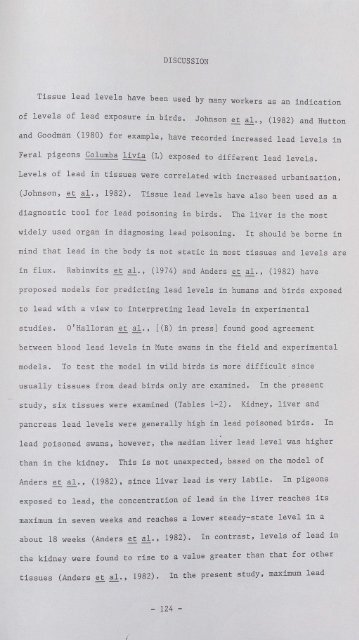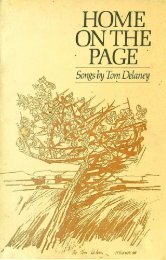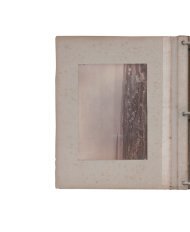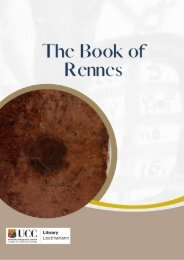Lead Toxicity in Mute Swans
LEAD TOXICITY IN MUTE SWANS Cygnus olor (Gmelin). By JOHN O'HALLORAN A thesis submitted to the National University of Ireland in candidature for the degree of Doctor of Philosophy September 1987
LEAD TOXICITY IN MUTE SWANS
Cygnus olor (Gmelin).
By
JOHN O'HALLORAN
A thesis submitted to the National University of Ireland
in candidature for the degree of Doctor of Philosophy
September 1987
You also want an ePaper? Increase the reach of your titles
YUMPU automatically turns print PDFs into web optimized ePapers that Google loves.
DISCUSSION<br />
Tissue lead levels have been used by many workers as an <strong>in</strong>dication<br />
of levels of lead exposure <strong>in</strong> bi"rds. J h (<br />
o nson et al., 1982) and Hutton<br />
and Goodman (1980) for example, have recorded <strong>in</strong>creased lead levels <strong>in</strong><br />
Feral pigeons Columba livia (L) exposed to different lead levels.<br />
Levels of lead <strong>in</strong> tissues were correlated with <strong>in</strong>creased urbanisation,<br />
(Johnson, et al., 1982).<br />
Tissue lead levels have also been used as a<br />
diagnostic tool for lead poison<strong>in</strong>g <strong>in</strong> birds.<br />
The liver is the most<br />
widely used organ <strong>in</strong> diagnos<strong>in</strong>g lead poison<strong>in</strong>g.<br />
It should be borne <strong>in</strong><br />
m<strong>in</strong>d that lead <strong>in</strong> the body is not static <strong>in</strong> most tissues and levels are<br />
<strong>in</strong> flux .<br />
Rab<strong>in</strong>wits et al., (1974) and Anders et al., (1982) have<br />
proposed models for predict<strong>in</strong>g lead levels <strong>in</strong> humans and birds exposed<br />
to lead with a view to <strong>in</strong>terpret<strong>in</strong>g lead levels <strong>in</strong> experimental<br />
studies.<br />
O'Halloran et al., [(B) <strong>in</strong> press] found good agreement<br />
between blood lead levels <strong>in</strong> <strong>Mute</strong> swans <strong>in</strong> the field and experimental<br />
models.<br />
To test the model <strong>in</strong> wild birds is more difficult s<strong>in</strong>ce<br />
usually tissues from dead birds only are exam<strong>in</strong>ed.<br />
In the present<br />
study, six tissues were exam<strong>in</strong>ed (Tables 1-2).<br />
Kidney, liver and<br />
pancreas lead levels were generally high <strong>in</strong> lead poisoned birds.<br />
In<br />
lead poisoned swans, however, the median liver lead level was higher<br />
than <strong>in</strong> the kidney.<br />
This is not unexpected, based on the model of<br />
Anders et al., (1982), s<strong>in</strong>ce liver lead is very labile. In pigeons<br />
exposed to lead, the concentration of lead <strong>in</strong> the liver reaches its<br />
maximum <strong>in</strong> seven weeks and reaches a lower steady-state level <strong>in</strong> a<br />
about 18 weeks (Anders et al., 1982).<br />
In contrast, levels of lead <strong>in</strong><br />
the kidney -were found to rise to a value greater than that for other<br />
1 1982) In the Present study, maximum lead<br />
tissues (Anders et~., ·<br />
- 124 -
















